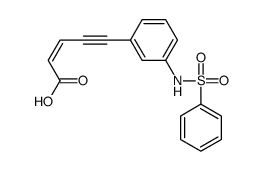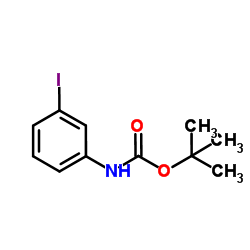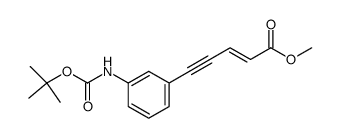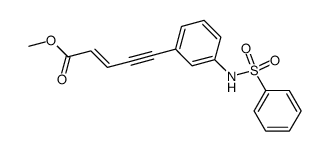151720-43-3
| Name | Oxamflatin |
|---|---|
| Synonyms |
2-Penten-4-ynamide, N-hydroxy-5-[3-[(phenylsulfonyl)amino]phenyl]-, (2E)-
(2E)-N-hydroxy-5-{3-[(phenylsulfonyl)amino]phenyl}pent-2-en-4-ynamide (2E)-N-Hydroxy-5-{3-[(phenylsulfonyl)amino]phenyl}-2-penten-4-ynamide (2E)-5-[3-(Phenylsulfonylamino)phenyl]-pent-2-en-4-ynohydroxamic acid (E)-5-[3-(benzenesulfonamido)phenyl]-N-hydroxypent-2-en-4-ynamide |
| Description | Oxamflatin (Metacept-3) is a potent HDAC inhibitor with an IC50 of 15.7 nM. |
|---|---|
| Related Catalog | |
| Target |
HDAC:15.7 nM (IC50) |
| In Vitro | Oxamflatin induces transcriptional activation of junD and morphological reversion in various NIH3T3-derived transformed cell lines. Oxamflatin shows antiproliferative activity against various mouse and human tumor cell lines with drastic changes in the cell morphology. Oxamflatin causes an elongated cell shape with filamentous protrusions as well as arrest of the cell cycle at the G1 phase in HeLa cells. Oxamflatin greatly enhances the transcriptional activity of the CMV promoter in a dose-dependent manner and inhibits intracellular HDAC activity[1]. Oxamflatin in the nanomolar range induces morphological changes in OVCAR-5 and SKOV-3 ovarian cancer cell lines. Treatment with oxamflatin also leads to decreased cell viability. Oxamflatin is able to significantly inhibit DNA synthesis and cell proliferation[2]. Oxamflatin can induce E-cadherin expression and also reduce cell viability in the MKN-45 cell line[3]. |
| In Vivo | Injection of oxamflatin, six times at the dose of 20 mg/kg, exhibits a significant increase in the days of survival (38% of ILS). The ILS of the mice treated with oxamflatin at the dose of 50 mg/kg is calculated to be more than 67% and one mouse survived over 60 days after tumor inoculation. No subsidiary effect, such as body weight loss, is observed at least up to this dose[1]. |
| Cell Assay | Cells grown in DMEM supplemented with 10% fetal bovine serum are challenged with serial two fold dilutions of oxamflatin on day 1 after the cells are seeded, and incubated for 2 days for the suspension cell cultures and for 3 days for the adherent cell cultures. Inhibition of the cell growth by oxamflatin is determined by staining with MTT as described previously[1]. |
| Animal Admin | Mice: Oxamflatin is injected intraperitoneally into BDF1 mice on day 1, 3, 5, 7, 9 and 11 and after the intraperitoneal inoculation of single cell suspension of the B16 melanoma cells. The survival days of the animals are recorded and the percent of increased life span (ILS%) is calculated[1]. |
| References |
| Density | 1.4±0.1 g/cm3 |
|---|---|
| Molecular Formula | C17H14N2O4S |
| Molecular Weight | 342.369 |
| Exact Mass | 342.067413 |
| PSA | 103.88000 |
| LogP | 3.26 |
| Index of Refraction | 1.686 |
| Storage condition | 2-8℃ |
| Personal Protective Equipment | Eyeshields;Gloves;type N95 (US);type P1 (EN143) respirator filter |
|---|---|
| Safety Phrases | S22 |
| RIDADR | NONH for all modes of transport |
| HS Code | 2935009090 |
|
~% 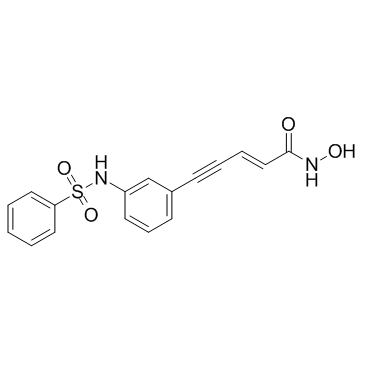
151720-43-3 |
| Literature: Journal of Medicinal Chemistry, , vol. 39, # 15 p. 2871 - 2873 |
|
~% 
151720-43-3 |
| Literature: Journal of Medicinal Chemistry, , vol. 39, # 15 p. 2871 - 2873 |
|
~% 
151720-43-3 |
| Literature: Journal of Medicinal Chemistry, , vol. 39, # 15 p. 2871 - 2873 |
|
~% 
151720-43-3 |
| Literature: Journal of Medicinal Chemistry, , vol. 39, # 15 p. 2871 - 2873 |
|
~% 
151720-43-3 |
| Literature: Journal of Medicinal Chemistry, , vol. 39, # 15 p. 2871 - 2873 |
|
~% 
151720-43-3 |
| Literature: Journal of Medicinal Chemistry, , vol. 39, # 15 p. 2871 - 2873 |
| Precursor 4 | |
|---|---|
| DownStream 0 | |
| HS Code | 2935009090 |
|---|---|
| Summary | 2935009090 other sulphonamides VAT:17.0% Tax rebate rate:9.0% Supervision conditions:none MFN tariff:6.5% General tariff:35.0% |
